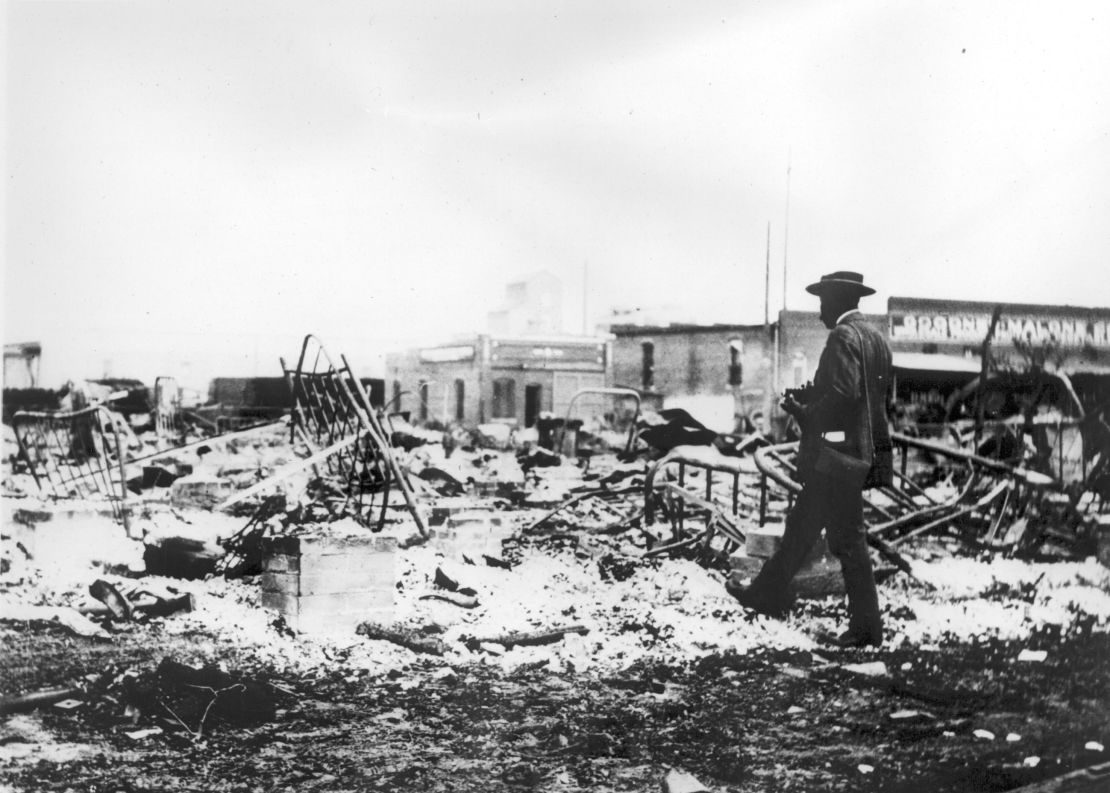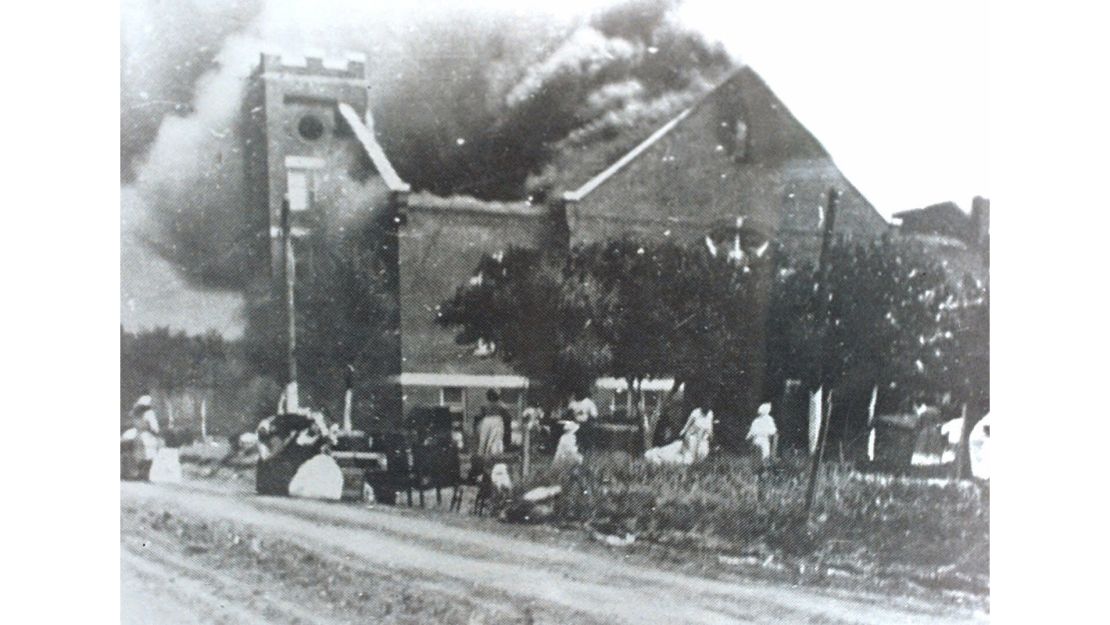The mayor can never make right the blight on Tulsa that is its 1921 race massacre, but finding the victims almost a century later could be an important step toward reconciliation.
“This is a matter of basic human decency,” Mayor G.T. Bynum said in a Tuesday statement posted to his Facebook page.
Bynum, who was a three-time councilman before winning the mayoral seat in 2016, said he and then-Councilman Jack Henderson interviewed people who had investigated the possibility of mass graves in 2012. They found that there were two cemeteries and a city park where victims from the massacre might have been dumped.
At Booker T. Washington Cemetery, researchers in the late 1990s found previously marked graves “in a disturbed state,” Bynum said.
In Oaklawn Cemetery, there is a grassy portion of the park with no marked graves. There, researchers detected an underground “abnormality” that could be consistent with a mass grave, though the researchers warned it could be a “pauper’s grave,” the mayor said. That’s the term for burial sites used by Tulsans who couldn’t afford proper funerals in the early 20th century.
A commission established to spread awareness of the 1921 killings and honor the victims spoke to a gentleman who, as a boy, recalled seeing bodies dumped there during the massacre, Bynum said.
“Henderson and I turned our findings over to the city administration, but nothing ever came of it,” he said in his statement. “I promised myself that if I ever became mayor and had the authority to direct further examination I would.”
Black Wall Street
In the 1920s, Tulsa had something many American states did not: The city’s Greenwood District played host to several black millionaires. There were doctors, pharmacists, entrepreneurs and a pilot with his own private plane.
Dubbed “Black Wall Street,” the area boasted more than 300 black-owned businesses, including two theaters.
Despite its black hub of commerce, Tulsa still experienced a great deal of racial strife. The mere existence of Black Wall Street was an affront to many whites, who felt, “How dare those Negroes have a grand piano in their house, and I don’t have a piano in my house,” Mechelle Brown, program coordinator for the Greenwood Cultural Center, told CNN during a 2016 interview.
The beginning of the end of this beacon of black opportunity came May 30, 1921, when African-American shoe shiner Dick Rowland, 19, hopped onto the elevator of a Main Street building with Sarah Page, the white 17-year-old who operated the elevator.

“This particular day after the elevator doors closed and Sarah Page and Dick Rowland were alone in the elevator a few moments, there was a scream,” Brown said.
The elevator doors opened. Rowland ran. Page initially claimed she’d been assaulted but never pressed charges, Brown said. By the end of the day, the local rumor mill was producing stories that Rowland had raped the girl.
Rowland was arrested the next day. Upon learning the news, local black residents – knowing they were risking their lives – decided to defend Rowland, who they didn’t feel was capable of rape. When they arrived at the courthouse, they encountered thousands of whites demanding Rowland be lynched.
There was a tussle between an armed white man and a black resident. A gun went off. The white resident was shot, and the angry white mob – by some estimates, 10,000 strong – later decided to storm Black Wall Street and the surrounding neighborhood.
“Blacks were so outnumbered and outgunned, whites eventually broke through the railroad tracks and invaded what was home to Black Wall Street, the Greenwood District,” Brown said.
‘My dad didn’t know where we were’
Within 16 hours, 35 city blocks were burned to the ground. Witnesses alleged that many of the buildings burned from the roof down after turpentine balls or nitroglycerin bombs were dropped from aircraft. Photos show dead African-American residents in the streets. Some of them had been shot.
Hazel Smith Jones, who died earlier this year at 99, told CNN in 2016 that she recalled white men rounding up residents and ferrying them out of the neighborhood. She was 3 at the time.
“My daddy wasn’t at home, just the kids and mama,” said Smith Jones, one of 13 children in her family. “They carried us to the fairgrounds and we was there for two or three days. … We stayed there and my dad didn’t know where we were.”
Numbers from the Greenwood Cultural Center help encapsulate the violence:
- Two black hospitals burned down
- 800 people admitted to white hospitals
- 1,256 residences destroyed
- 6,000 black Greenwood residents arrested
- 10,000 people left homeless
- $26 million in damages ($366 million today)
Though the state’s official death toll is 36, some estimates peg the number at 300.
“There’s really no way of knowing exactly how many people died. We know that there were several thousand unaccounted for,” Brown said, adding that many survivors of the massacre fled the city.

With black residents rounded up by the mob, arrested or dead, looters cleaned out their homes and businesses. Black residents returned to nothing. Their misery was compounded when insurance companies denied $2.7 million in claims for the Greenwood District.
“They never received any justice for losing their loved ones, their homes and the businesses that they worked so hard for, that they built from the ground up,” Brown said.
A local newspaper applauded the violence, posting an editorial that said, “Such a district as the old‘n—–town’ must never be allowed in Tulsa again.”
A step toward reconciliation?
Black Wall Street was rebuilt, but never to its former glory.
Mayor Bynum is hoping that working to find graves will provide solace to the victims’ descendants and the city in general. He concedes there may be no graves when it’s said and done.
If graves are located, the team behind the effort will work to determine if they appear to be victims of violence, and then, if the remains can be dated to 1921.
“Tulsans are compassionate and supportive toward victims of violent crime – and that standard should apply whether they are victims in 2018 or 1921. All Tulsans deserve to know what happened in 1921 – especially the descendants of victims,” Bynum wrote. “The only way to move forward in our work to bring about reconciliation in Tulsa is by seeking the truth honestly.”
CNN’s Sara Sidner contributed to this report.





